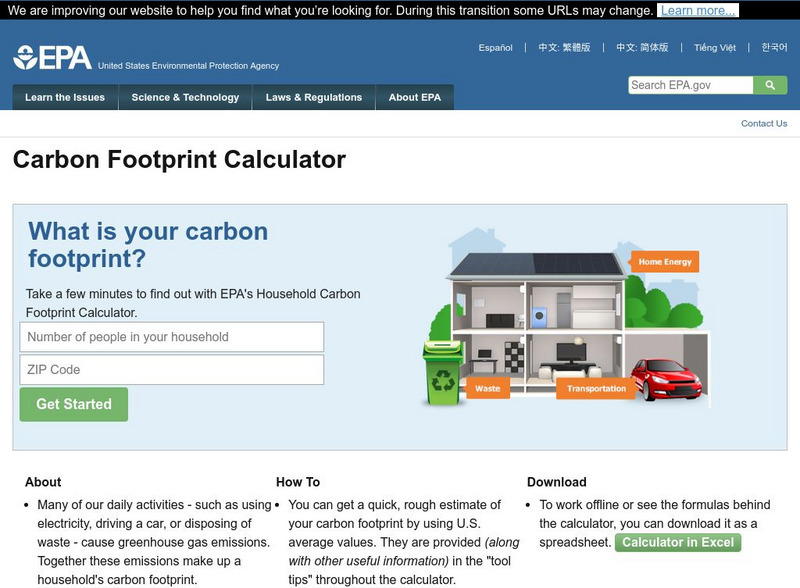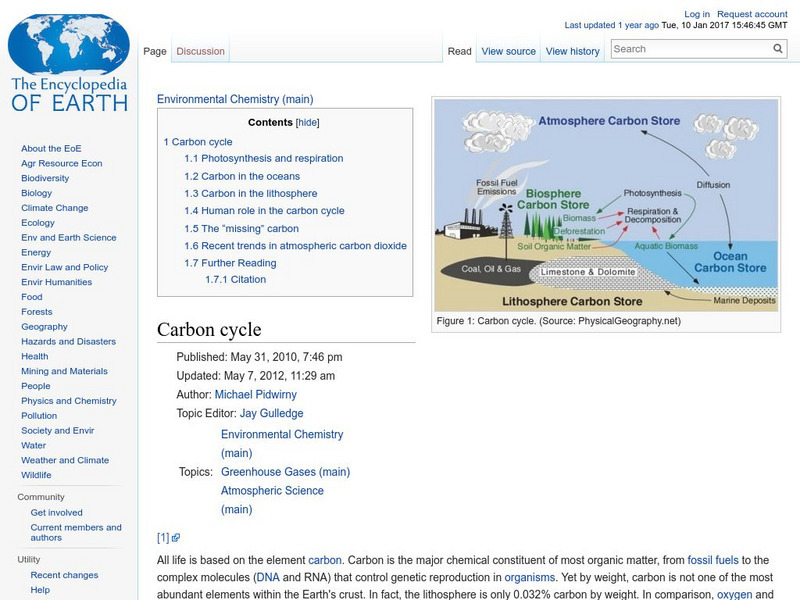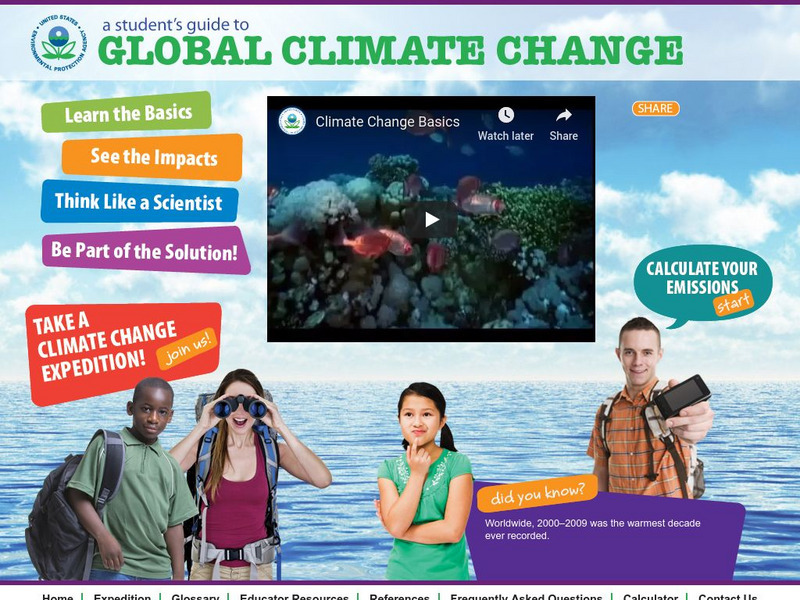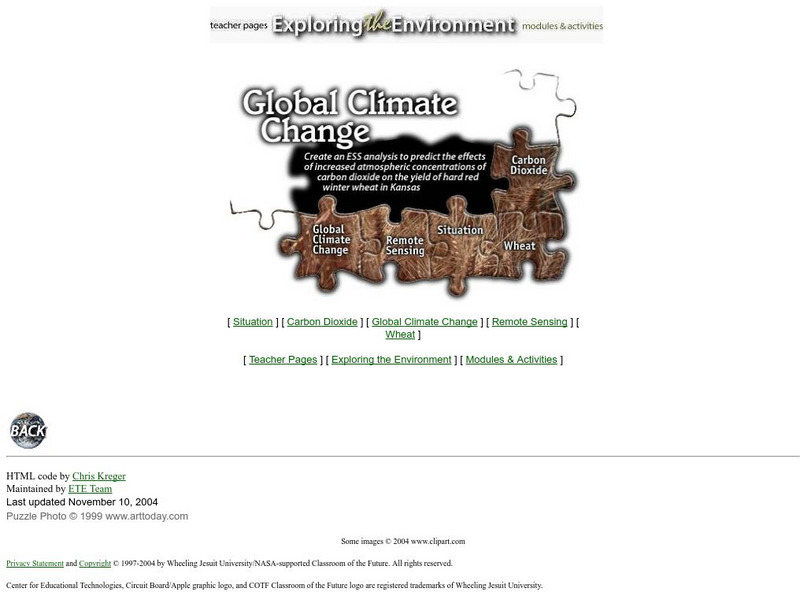US Environmental Protection Agency
Epa: Greenhouse Gas (Ghg) Emissions
Earth's atmosphere contains greenhouse gases. Find out what these gases are and where they come from. Also link to other information about how greenhouse gases contribute to climate change.
Chem4kids
Chem4 Kids: Carbon
Click on the left navigation terms for some great information about the 6th element in the periodic table, "carbon." Content focuses on carbon's electrons, where you can find carbon in nature and in the home, and how carbon combines with...
Annenberg Foundation
Annenberg Learner: The Habitable Planet: Energy Challenges
With this resource, users join investigators in the exploration of humans' use of and dependence on the many energy resources. Learn about new technologies such as carbon capture and sequestration as an alternative to reduce our carbon...
US Environmental Protection Agency
Epa: Household Carbon Footprint Calculator
Enter your household energy data to find out your family's total carbon footprint. Explore some actions to take to reduce your carbon emissions, and then find out your estimated savings once you take those steps.
Encyclopedia of Earth
Encyclopedia of Earth: Environmental Chemistry: Carbon Cycle
Article explaining the importance of carbon as the basis for life, carbon dioxide's role in photosynthesis and respiration, carbon in the ocean and lithosphere, the impact of human activities on the carbon cycle, carbon that seems to be...
King's Centre for Visualization in Science
Explaining Climate Change: Lesson 7: Climate Feedback Loops
This is the seventh lesson in a series of learning modules on the topic of climate change. In this lesson, you will learn how several important feedback loops help drive and regulate earth's unique climate system and affect climate...
PBS
Kqed: What Are Greenhouse Gases and Where Do They Come From?
Use this interactive infographic to learn about sources of the main greenhouse gases. Read facts, figures, and statistics about four important gases in the atmosphere.
University of California
Organic Chemistry Page: A Brief Tutorial on Drawing Lewis Dot Structures
An excellent lesson on writing Lewis structures. Examples shown include ammonium ion, carbon dioxide and the carbonate ion.
King's Centre for Visualization in Science
Explaining Climate Change: Lesson 6: Greenhouse Gases: A Closer Look
This is the sixth lesson in a series of learning modules on the topic of climate change. It takes a look at the different important greenhouse gases in our atmosphere and some of the ways in which humanity is affecting the atmospheric...
PBS
Pbs Learning Media: Global Warming: Graphs Tell the Story
Examine these graphs from the NOVA/ FRONTLINE Web site to see dramatic increases in the temperature of Earth's surface and greenhouse gases in the atmosphere.
Other
Water on the Web
Water on the Web (WOW) is an advanced site allowing students to actively participate in data analysis from real research sites. Lesson plans on a range of topics are provided. There is also a tutorial for using Excel to graph WOW data.
US Environmental Protection Agency
Epa: A Student's Guide to Global Climate Change
The signs of global climate change are becoming more and more evident. The EPA provides an excellent guide for students that acquaints them with the basic causes, effects on people and the environment, and solutions that they can engage...
Other
Gfdl: Temperature (F) Response Due to Increased Atmospheric Co2
An animated model of the Earth from the Geophysical Fluid Dynamics Laboratory showing how global temperatures increased from 1870 to 2100 due to rising amounts of carbon dioxide in the atmosphere.
PBS
Pbs Learning Media: Photosynthesis
This video segment from Interactive NOVA: "Earth" looks at photosynthesis, the chemical process plants use to make their own food.
Virginia Tech
Virginia Polytechnic Institute: Greenhouse Dinosaur Extinction Theory
This comprehensive page discusses the Asteroid Impact vs. Volcano-Greenhouse dinosaur extinction debate. It was written by paleontologist, professor, and scientist Dr. Dewey McLean.
TED Talks
Ted: Ted Ed: The Carbon Cycle
Video talks about the carbon cycle and uses a computer as a metaphor to show how the cycle can be disrupted by climate change. [3:55] Includes a short quiz and a list of additional resources to explore.
Center for Educational Technologies
Exploring the Environment: Global Climate Change
This tutorial looks at carbon dioxide in the atmosphere and how changes can impact wheat production in Kansas.
PBS
Pbs Learning Media: Global Warming: Carbon Dioxide and the Greenhouse Effect
This video segment adapted from NOVA/FRONTLINE demonstrates the physical property of carbon dioxide that causes the greenhouse effect. Includes background reading and discussion questions. [2:26]
Science Museum, London
Science Museum: Climate Science Info Zone
Media-rich interactive explores Earth's climate, investigating what might be causing the climate to change and how to prepare for it in the future.
Michigan Reach Out
Michigan Reach Out: Do Plants Need Sunlight?
Do plants need sunlight? What happens to plants if they do not get sunlight? Students will act like scientists in order to answer these questions. A scientist takes questions like this and then conducts an experiment to see what really...
Nature Research
Nature Education: Energy Economics in Ecosystems
This article discusses how plants and microorganisms, until recently, have mostly controlled how much carbon dioxide is released into an ecosystem, and explains how this process works. Humans' burning of fossil fuels has upset the...
American Museum of Natural History
American Museum of Natural History: Ology: Rising Co2! What Can We Do?
With this resource, students learn how much fossil fuel emissions have increased since 1600 by exploring a graph showing carbon dioxide in our atmosphere. Then answer questions and read facts about climate change over the centuries....
American Chemical Society
Middle School Chemistry: Lesson Plans: Can Gases Dissolve in Water?
An activity through which students learn why gas is able to dissolve in water, and how heat affects the solubility of a gas in a liquid.
University Corporation for Atmospheric Research
Ucar: Plugged in to Co2
Students analyze the energy consumption of a household appliance and estimate the amount of carbon dioxide it is adding to the atmosphere each year.
















